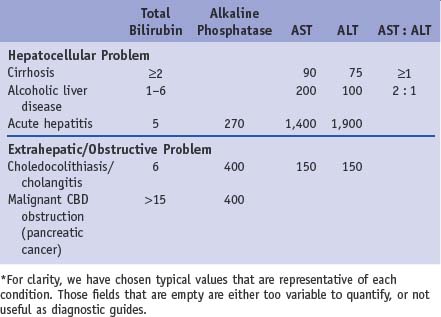Chapter 29 63-Year-Old Female with Jaundice (Case 18)
| Hepatocellular Causes | Extrahepatic/Obstructive Causes |
|---|---|
| Viral hepatitis | Choledocholithiasis |
| Alcoholic hepatitis | Cholangitis |
| Drug-induced hepatitis | Benign stricture |
| End-stage liver disease | Periampullary cancer* |
* Includes pancreatic cancer, cholangiocarcinoma, ampullary carcinoma, and duodenal carcinoma.
PATIENT CARE
History
• In an elderly patient presenting with painless jaundice, think malignancy: look for weight loss and poor appetite.
• If the jaundiced patient has abdominal pain, the specifics of the pain are important: intermittent RUQ pain followed by a severe, more constant pain could represent choledocholithiasis with a stone impacted in the distal CBD. Vague RUQ pain may be the result of distention of the liver capsule associated with hepatitis; chronic epigastric/RUQ pain that is boring in nature may be related to pancreatic cancer as it invades adjacent tissue.
Physical Examination
• Jaundice is visible as a yellow color in the skin, under the tongue, or in the sclera of the eyes. This occurs when the bilirubin level rises above 3.5 mg/dL.
• Encephalopathy or asterixis (flapping of hands with arms fully extended) point to hepatocellular/liver disease.
• Look for signs of chronic liver disease such as spider telangectasias, palmar erythema, and caput medusa.
Intepretation of Liver Function Tests
An AST : ALT ratio of 2 : 1 is indicative of alcoholic liver disease. See Table 29-1 for laboratory data typical for certain disorders.
Tests for Consideration
| $30 | |
| $56 |
| Clinical Entities | Medical Knowledge |
|---|---|
| Choledocholithiasis | |
| PΦ | Choledocholithiasis refers to the presence of gallstones in the CBD. These stones typically originate in the gallbladder and traverse the cystic duct to enter the common bile duct. Occasionally stones may form primarily in the bile ducts, but this is difficult to prove unless the gallbladder has been removed more than 1 to 2 years previously. CBD stones found less than 2 years from cholecystectomy are assumed to be “retained” stones. Stones may bounce around the ducts, pass through the ampulla of Vater, or become lodged, causing obstruction. |
| TP | The typical patient presents with RUQ abdominal pain associated with episodic jaundice. Intermittent obstruction may occur several times before medical attention is sought. |
| Dx | Dx begins with the observation of jaundice followed by LFTs, which will demonstrate an obstructive pattern, and ultrasonography, which will often demonstrate dilatation of the intrahepatic ducts. Stones are frequently identified in the gallbladder, but are often not visualized in the CBD. |
| Tx | Tx of CBD stones depends on local expertise. Most patients will need laparoscopic cholecystectomy in the near future. If cholecystectomy with laparoscopic CBD exploration can be performed with good results, this may be the tx of choice as it requires only a single procedure. In most centers, however, the practice is to perform a laparoscopic cholecystectomy with either a pre or postoperative ERCP for clearance of the CBD by endoscopic sphincterotomy with stone extraction. See Sabiston 54, Becker 17. |
Stay updated, free articles. Join our Telegram channel

Full access? Get Clinical Tree



